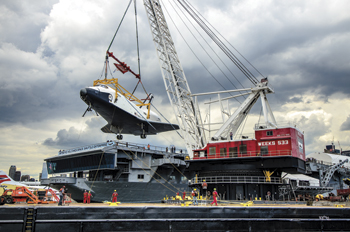With a late afternoon storm threatening, the space shuttle Enterprise made its final atmospheric flight in the form of a crane lift from the deck of a Weeks Marine barge onto the flight deck of the retired aircraft carrier USS Intrepid.
There are not that many famous cranes around, but Weeks 533, a 500-ton capacity crane on a 300-foot crane barge, strikes a familiar chord in the minds of many. Some remember watching 533 lifting the British Airways Concorde onto the Intrepid Sea, Air & Space Museum site on the Hudson River in Manhattan. Many others remember the giant’s boom plucking the downed body of US Airways Flight 1549 from the Hudson River in 2009.
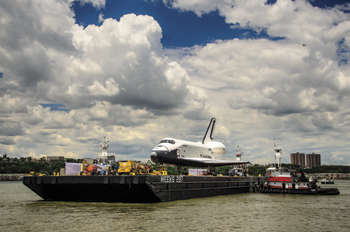 |
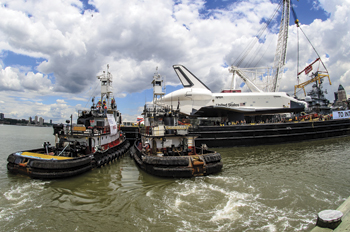 |
|
Above: barge Weeks 297 and three tugs, including Kathleen Weeks, float the space shuttle Enterprise up the Hudson River. Below: Shelby Weeks and Elizabeth Weeks push 297 up against the crane barge. Brian Gauvin photos |
On June 6, with the international media and a crush of people watching from the museum’s Pier 84, 533 was back in the spotlight, lifting Enterprise onto the flight deck of the carrier Intrepid. The trip up the Hudson was a photo event featuring Weeks 533 with the tug Elizabeth Weeks made up on the stern, and Enterprise on the barge Weeks 297, with Shelby Weeks pushing. Accompanying the tow was a flotilla of workboats, recreation boats, excursion boats, harbor patrol boats and fireboats with their monitors shooting jets of water into the air.
It was the third leg of a journey that began in April, when Enterprise was secured onto a Boeing 747 Shuttle Carrier Aircraft at Washington Dulles International Airport and flown to John F. Kennedy International Airport in New York. The second leg was a barge tow from Jamaica Bay to the Weeks yard in Jersey City, N.J. Along the way, a 35-mph gust of wind blew the barge sideways, causing the starboard wingtip of Enterprise to rub against a wood piling. The damage was superficial and repaired before the shuttle was moved to the Intrepid museum.
At the museum, Elizabeth, assisted by Kathleen Weeks, maneuvered 533 into position alongside Intrepid and dropped the spuds, stabilizing the barge. Then the tug Shelby Weeks, assisted by Elizabeth and Kathleen, moved the Enterprise tow into position alongside 533. It took about three hours to free Enterprise from its bonds and to rig the shuttle to a spreader frame shackled to the boom of 533.
Bound by gravity all its life, Enterprise had never flown in space, but was employed by NASA for atmospheric test flights. As Enterprise touched down on Intrepid, at sea level, the crowd cheered and clapped for its final landing.
In comparison, the scene two days later was a normal Manhattan buzz while the Weeks Marine heavy lift team, lead by Heavy Lift Supervisor Donny Benesch, finished up securing Enterprise to the deck of Intrepid. For the lift, Benesch explained, the concern was adjusting the rigging to accommodate a single point hookup to the spreader frame used for lifting the shuttle.
“Normally the hook would be in the middle, but in the case of the shuttle, the hook had to be aft of the center of the shuttle, over the vehicle’s center of gravity, in order to have an even lift and landing on Intrepid,” said Benesch. “You have to be very careful with the lift on land, but on the barge you have the added element of working on water, not a solid surface. You have barge motion so you have to be even more careful.”
On board Elizabeth, Capt. Ben Peterson, who had just relieved Capt. Dan Smith, made his way up the ladder to the upper wheelhouse. It was time to return Weeks 533 to the yard in Jersey City. Engineer Stephen Goodson and AB Matt Nicastro made up to the starboard stern of the barge. Visibility, even from the upper wheelhouse of Elizabeth, was severely restricted by the bulk of the crane, but Peterson was in constant contact with Goodson, Nicastro, or Benesch keeping watch on the bow of the barge.
“It was a bit daunting bringing in such a big piece of equipment with all those people watching,” said Peterson. “And you can only see down one half of the barge. You just can’t see as much as you’d like to see. So it was daunting but that’s what we enjoy. We enjoy the complexity of it.”
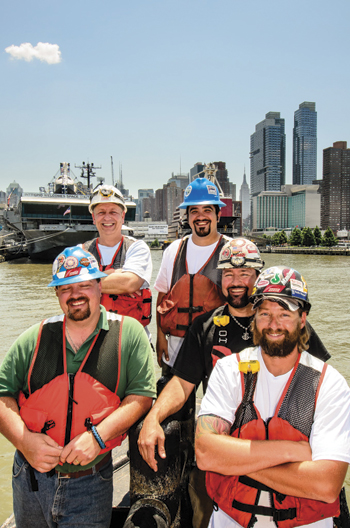 |
|
The crew of the tugboat Elizabeth Weeks, clockwise from left foreground, Capt. Ben Peterson, Capt. Dan Smith, AB Matt Nicastro, Engineer Stephen Goodson and Heavy-Lift Supervisor Donny Benesch. |
Both the crew of Elizabeth and Benesch’s heavy lift team had already visited the slip alongside the museum, having previously brought in huge transformers for the city.
“So we have some familiarity,” said Peterson. “But for this job we had to be on a very specific spot in order for the crane to swing the shuttle onto its spot. And we’ve been working with Donny and the heavy lift crew for years. We know them and they know us. The biggest thing is the continuity.”
Because of time constraints for the shuttle move, the Weeks crews had to bring the barge in on the end of the flood tide. In the past they were able to time the transformer moves for slack tide. And then there is the wind.
“The barge is not very heavy for her size and because of all the windage, with the crane on her, you have to be thinking a few steps ahead all the time,” said Peterson. From experience, Peterson explained, there is a point when the tow is so far into the slip that more than plan B is needed. “I want to have a plan Zebra,” he said. “Should we put a spud down or is there enough room in there for the assist tug on the blind side going into the Intrepid slip. You have to have a feel for it.”
Crowley crews tow battleship Iowa
The decommissioned USS Iowa (BB-61), dubbed the “World’s Greatest Naval Ship,” and a ship of stories that include being the flagship for the surrender ceremony in Tokyo Bay in 1945 (the actual signing took place aboard USS Missouri), has finally found a retirement home.
Iowa is also known as the “Battleship of Presidents,” having hosted Franklin Delano Roosevelt, Ronald Reagan and George H.W. Bush. Last year the U.S. Navy donated Iowa to the Pacific Battleship Center (PBC), a non-profit organization formed in 2009, to transform the floating giant into a museum and educational attraction at the Port of Los Angeles.
The 887-foot battleship was built in 1940 at a cost of $110 million. The current replacement cost listed on the PBC website is $2.5 billion.
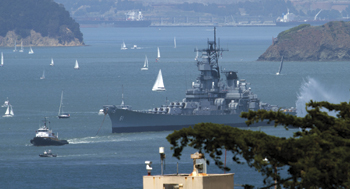 |
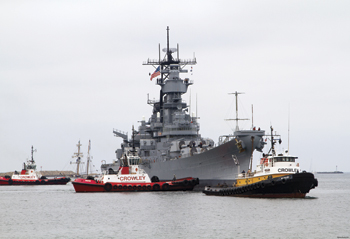 |
|
Above: the tugboat Warrior tows the battleship USS Iowa out of San Francisco Bay. Below: the flotilla enters Los Angeles Harbor with Warrior, right, towing at Iowa’s bow with assistance from Leader, left, and Master, center. |
The PBC awarded Crowley Maritime the contract to tow Iowa from the Port of Richmond in San Francisco Bay to Pier 87 in the Port of Los Angeles. Crowley has experience in ocean tows of other retired battleships, notably USS Missouri from Washington to Pearl Harbor in 1998. “The battleship group was a great group to work with,” said Crowley Port Captain Andrew Gauthier. “Very knowledgeable. They really had their ducks in a row. We were fortunate that they chose us because we are the company that has handled the other battleships.”
The first leg of the Iowa tow was from Richmond, to anchor four miles off the Port of Los Angeles, where the battleship underwent a hull scraping to rid it of any invasive species or contaminants that might reside there. Three Crowley tractor tugs — Goliath, Delta Billy and Patricia Ann — assisted the 7,200-hp ocean tug Warrior, with a single-point makeup, under the Golden Gate Bridge and out of the bay.
“The makeup is never standard when you’re moving something that big,” said Gauthier. “We removed the anchor in Iowa’s hawsepipe and used the ship’s chain to get us to the water’s edge. Then we came in with three shots of three-inch stud link ship’s chain for surge gear and towed her on that — a single point on the bull nose. That was for a short coastal tow. If we were towing a ship to Hawaii we would probably use five shots. Everything went by the numbers. I couldn’t be happier with the way it went.”
The second leg of Iowa’s final journey was actually in two parts with Crowley’s Harbor-class cycloidal-drive tugs Leader, Admiral, Scout and Master assisting Warrior. First Iowa was towed to Pier 51 where the ship was prepared for presentation and then on to Pier 87 on June 9.
“On the move from outside the L.A. harbor to Pier 51 and then 87, the only thing that was really different for me was that there were just under a thousand people on board (Iowa),” said Gauthier. “That was a little bit different from normal operations — having to deal with lots of people. It was a circus, but aside from that, things couldn’t have gone better.”
Before the tow from Richmond, however, Gauthier described the challenges of moving the ship from the Navy’s mothball fleet in Suisun Bay, north of San Francisco, to Richmond.
“We brought the ship down from Suisun Bay in October,” said Gauthier. “And that was probably the most critical move because she sat up in Suisun Bay since 2001. In those 11 years they built a bridge where the deep water is. So we had some shoaling issues to deal with.”
Dredging was an obvious solution to shoaling but short money and the challenges presented by California’s environmental law pushed that fix aside. So, armed with the best soundings available, Gauthier and the tug crews worked out a plan to get the ship over the shoal.
“We had about six inches under the bottom, moving more or less sideways over the shoal area,” said Gauthier. “We were about a hundred feet off the bridge and it got shallower as you got away from the bridge. When the ship went over the shoal it was drawing 34 feet of water on the stern and 27.5 on the bow. So we had to keep the stern close to the bridge in the deepest water. We actually went stern first down Suisun Bay and across the shoal sideways and through the bridge, stern first. That was a very critical element for the start of the project.”
The Iowa museum opened at Pier 87 in San Pedro on July 7.

